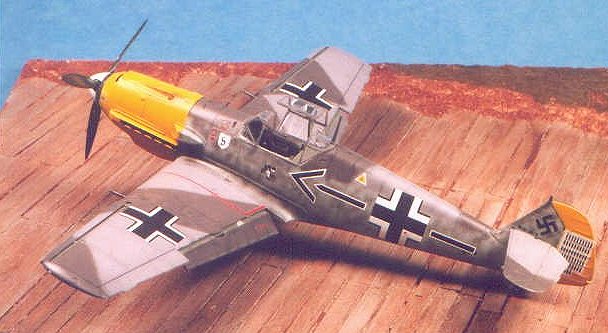
|
KIT: |
Tamiya 1/48 Bf-109E-4 |
|
KIT # |
61063 |
|
PRICE: |
$27.95 |
|
DECALS: |
See Review |
|
REVIEW & |
|
|
NOTES: |
Superscale 48-701 Decal sheet used |

|
HISTORY |
Dolfo's Emil:
Since the development history of the Bf-109E series is well-known and available here with other reviews, this will focus on the role of Adolf Galland's role in the development of different camouflage and markings during the Battle of Britain that resulted in the Bf-109E-4N he flew from September 1940 to March 1941.
Before the Second World War, both the Luftwaffe and the Royal Air Force were most concerned with attacks on their aircraft while on the ground. The result was the pre-war Luftwaffe camouflage of two dark greens applied over all the upper surfaces, and the RAF's camouflage of dark earth and dark green on the upper surfaces. Neither of these were good colors for airborne camouflage, since they resulted in very dark colored airplanes that were easily silhouetted against a sky background.
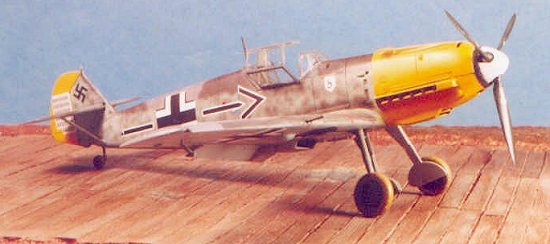 The Luftwaffe was the first to respond to this as a result of their
experience of air combat in Poland in September 1939. In January, 1940, the
fuselage sides of the Bf-109s were repainted with RLM65 Hellblau
extending up the side of the fuselage as far as the cockpit sill. Additionally,
the national insignia was enlarged so it would be more visible in air combat. By
this time, it had been discovered that the possibility of being shot down by
someone on your own side was a real problem, and the issue of air-to-air
identification became more important. The British response was to maintain the
dark colors since they still expected to be attacked, and to return to the use
of fuselage national insignia with the outer yellow ring, for increased
visibility and ease of identification.
The Luftwaffe was the first to respond to this as a result of their
experience of air combat in Poland in September 1939. In January, 1940, the
fuselage sides of the Bf-109s were repainted with RLM65 Hellblau
extending up the side of the fuselage as far as the cockpit sill. Additionally,
the national insignia was enlarged so it would be more visible in air combat. By
this time, it had been discovered that the possibility of being shot down by
someone on your own side was a real problem, and the issue of air-to-air
identification became more important. The British response was to maintain the
dark colors since they still expected to be attacked, and to return to the use
of fuselage national insignia with the outer yellow ring, for increased
visibility and ease of identification.
The Jagdgeschwader also experimented with lightening the overall camouflage colors by replacing RLM70 Schwartzgrun with RLM02 Graugrun. By the time of the invasion of the West in May 1940, probably half the German fighters were in this lighter camouflage.
The stage was now set for what would become the Battle of Britain. The early part of the fighting involved air combat over the English Channel, and the Luftwaffe pilots discovered the camouflage they were using was once again inappropriate for the conditions, and that the problem of aerial identification was worse as fighter combat involved larger numbers in quicker fights.
At the time, Adolf Galland was Gruppenkommandeur of III/JG26. He initiated some experiments in camouflage, using RLM65 blue and different greys in different patterns. One aircraft he was known to use at this time was overall RLM65, with RLM75 Grauviolett dappling. Other aircraft used different shades of grey from very light to very dark, in dapple patterns and in more official-looking "splinter" patterns. Additionally, other units were dappling the sides of their aircraft with RLM02, RLM71 Dunkelgrun, and various shades of grey. For modelers, the Bf-109s on the Channel Front during July-September 1940 are a painter's delight, with all these differences.
The issue of air-to-air identification became so important that the groups adopted the practice of painting large areas of the airplane - primarily the nose, the rudder and the wingtips - in bright, easily-spotted colors, generally white or yellow. This would seem counterintuitive to the issue of camouflage, and shows by its presence just how much a problem "friendly fire" was.
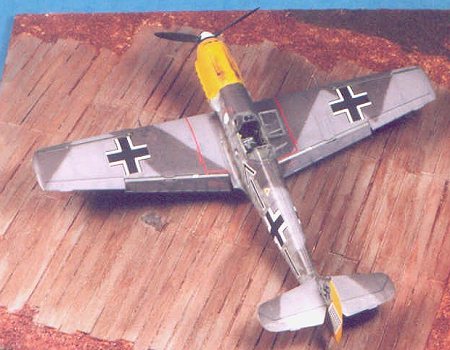 Galland moved up to become Kommodore of JG26 on August 18, 1940.
Despite the pace of operations, he managed to get the majority of the groups
aircraft repainted in the more neutral camouflage colors, and also adopted the
practice of painting the entire engine cowling yellow. As a result, JG26 would
become known to their RAF opponents as "the yellow noses," or "the yellow-nose
Abbeville boys." In fact, other groups such as JG2, JG51 and JG52 also adopted
the use of yellow markings at this time. However, JG26's aggressiveness and
prowess in battle got them noticed more.
Galland moved up to become Kommodore of JG26 on August 18, 1940.
Despite the pace of operations, he managed to get the majority of the groups
aircraft repainted in the more neutral camouflage colors, and also adopted the
practice of painting the entire engine cowling yellow. As a result, JG26 would
become known to their RAF opponents as "the yellow noses," or "the yellow-nose
Abbeville boys." In fact, other groups such as JG2, JG51 and JG52 also adopted
the use of yellow markings at this time. However, JG26's aggressiveness and
prowess in battle got them noticed more.
The German armed forces have traditionally considered camouflage very important, and the Reichluftfartministerium (RLM) had been following the issue of camouflage quite closely during this period, looking for a camouflage pattern that could be factory-applied to do the job. By mid-August, they had determined that the best colors were RLM74 Graugrun and RLM75 Grauviolett for the upper surface camouflage, with RLM76 Blaugrau for the lower surfaces, with a dappling on the fuselage sides of RLM02, RLM74 and RLM75. This order went to the factories by the end of August and was implemented quickly.
As one of the leading lights of the Jagdwaffe, Galland received one of the first examples out of the factory in this scheme, a Bf-109E-4/N, Werkenummer 5819. JG26 had continued the use of pre-war staff markings, and over the weeks of September, 1940 after he received the airplane around September 10, the "arrow" marking of a Kommodore was applied to the fuselage fore and aft of the insignia, with his traditional "Mickey Mouse" badge finally applied in November, according to photographs of the airplane.
Galland flew this airplane through all the fighting of the later stages of the Battle of Britain and at the beginning of the RAF raids into northern France in 1941. He scored more victories in this airplane than any other single aircraft he had flown, approximately 30 of his score of 69 at the time the unit was re-equipped with the Bf-109F in March 1941. Galland initially considered the Bf-109F - with its armament of one 15mm cannon and two 7.62mm machine guns - to be a "retrograde step" and continued to fly his Emil until expressly ordered to fly the Friedrich; even then he managed to convince Messerschmitt to provide him with two more heavily-armed airplanes - one with 13mm machine guns that were far more neatly cowled than they would be when officially introduced on the Bf-109G-6, and one with 20mm cannon in the wings, like an Emil.
|
THE KIT |
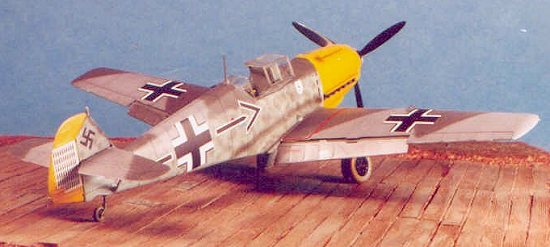 When Tamiya released its Bf-109E kit, my first thought was "why?" given that
Hasegawa was doing such a bang-up job releasing 109s at the time. The fact that
the Tamiya kit turned out to be quite inaccurate in outline, as well as far more
"overdone" in terms of exterior detail, than the Hasegawa kits confirmed to me
the superiority of the Hasegawa product, and I managed to successfully resist
adding the kit to my collection. That changed this past Spring, when the good
folks at Tamiya American gave out free kits of the Bf-109E at their TamiyaCon.
When Tamiya released its Bf-109E kit, my first thought was "why?" given that
Hasegawa was doing such a bang-up job releasing 109s at the time. The fact that
the Tamiya kit turned out to be quite inaccurate in outline, as well as far more
"overdone" in terms of exterior detail, than the Hasegawa kits confirmed to me
the superiority of the Hasegawa product, and I managed to successfully resist
adding the kit to my collection. That changed this past Spring, when the good
folks at Tamiya American gave out free kits of the Bf-109E at their TamiyaCon.
Looking at the kit and comparing it to its Hasegawa competition, the Tamiya kit wins points only on basic kit engineering, in that it is easier to assemble than its competitor - truly an example of the Tamiya "shake 'n' bake" design philosophy. Out of the box, however, the cockpit is inferior to the Hasegawa kit, and I think such things as the fabric detail on the ailerons, flaps, elevators and rudder is extremely overdone, while the aileron mass balances are well-molded "blobs" at best. One could sand this overdone detail down if they thought it was important.
|
CONSTRUCTION |
There are other reviews here that provide sufficient detail about assembling this kit, and I have nothing new to repeat. Needless to say, the kit went together as a snap, assembled in an evening and left overnight for the glue to set up. I did not add the radio antenna, aileron mass balances or pitot tube at this point. I painted the cockpit interior in Tamiya XF-22 "RLM Grey." There has been some question as to exactly when the factory changed over to the RLM66 Schwartzgrau color for cockpits. Most sources say that happened in November, 1940, and others say it happened with the changeover of production to the Bf-109F - which also started in November 1940. At any rate, I believe doing this particular airplane in RLM02 for the cockpit is a safe choice. I did use a left-over resin cockpit from an MPM Bf-109E, which provided better detail than the over-simplified kit cockpit.
|
PAINT & DECALS |
Painting:
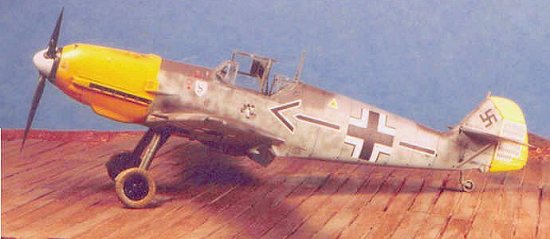 I used Gunze-Sanyo colors for all the camouflage painting. After pre-shading
the model with flat black along the panel lines, I painted the nose and rudder
with H-413 "Gelb04", masked them off and shot the lower surfaces with H-417
RLM76 "Blue-Grey." I dappled the fuselage with Tamiya XF-22 "RLM Grey," "H-68
"RLM Grey 74" and H-75 "Dark Sea Grey" - which I think is a more accurate
representation of RLM75 Grey, due to its violet tinge. I then freehanded the
splinter camouflage pattern shown in the Tamiya kit. The prop was painted H65
"RLM Black Green."
I used Gunze-Sanyo colors for all the camouflage painting. After pre-shading
the model with flat black along the panel lines, I painted the nose and rudder
with H-413 "Gelb04", masked them off and shot the lower surfaces with H-417
RLM76 "Blue-Grey." I dappled the fuselage with Tamiya XF-22 "RLM Grey," "H-68
"RLM Grey 74" and H-75 "Dark Sea Grey" - which I think is a more accurate
representation of RLM75 Grey, due to its violet tinge. I then freehanded the
splinter camouflage pattern shown in the Tamiya kit. The prop was painted H65
"RLM Black Green."
Decals:
The release of SuperScale decal sheet 48-701, which has Adolf Galland's and Helmut Wick's Battle of Britain airplanes as the subject matter, was what had originally gotten me interested in building the model, which had been gathering dust in the pile prior to that event. As with all the recent SuperScale releases, the decals seem accurate, and go on well with Micro-Sol as the solvent. When everything had set up, I washed the model to get rid of dried-on setting solution, and shot the model with another coat of Future. When that was dry, I applied exhaust staining and oil staining to the fuselage, and gunfire residue to the fuselage weapons, then shot two coats of thinned Testor's Dullcote. I did little other weathering because all the photos I have seen of this airplane show it very well-maintained and clean.
Final Assembly:
I attached the aileron mass balances, pitot tube, landing gear, prop and canopy.
|
CONCLUSIONS |
The model looks nice when completed. I still think the surface detail is too heavy, but it looks less so under a few coats of paint. I have had the opportunity to pick up two other Tamiya Bf-109E kits at bargain rates, and they too now grace the shelves - one done out of the box as "White 12" and one done as one of the JG26 airplanes from the Battle of Britain "Rot 2" in RLM02/79/65 with overall yellow nose and dapple. I do still think that the Hasegawa kit is overall the better in terms of accuracy and fidelity of detail.
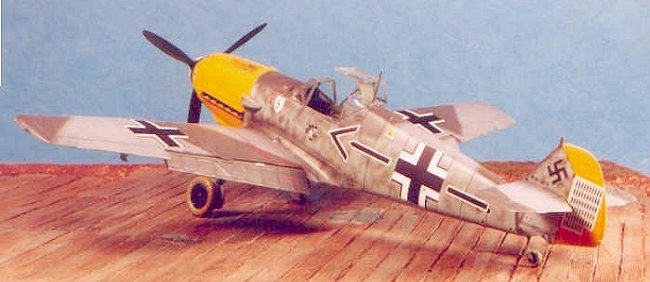
Decals courtesy of
 .
.
If you would like your product reviewed fairly and quickly by a site that has thousands of visits a day, please contact me or see other details in the Note to Contributors.